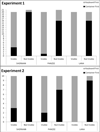Language-trained chimpanzees (Pan troglodytes) name what they have seen but look first at what they have not seen
- PMID: 23508741
- PMCID: PMC3902479
- DOI: 10.1177/0956797612458936
Language-trained chimpanzees (Pan troglodytes) name what they have seen but look first at what they have not seen
Abstract
Metacognition can be defined as knowing what one knows, and the question of whether nonhuman animals are metacognitive has driven an intense debate. We tested 3 language-trained chimpanzees in an information-seeking task in which the identity of a food item was the critical piece of information needed to obtain the food. The chimpanzees could either report the identity of the food immediately or first check a container in which the food had been hidden. In two experiments, the chimpanzees were significantly more likely to visit the container first on trials in which they could not know its contents but were more likely to just name the food item without looking into the container on trials in which they had seen its contents. Thus, chimpanzees showed efficient information-seeking behavior that suggested they knew what they had or had not already seen when it was time to name a hidden item.
Keywords: Pan troglodytes; chimpanzees; comparative psychology; decision making; information seeking; metacognition; problem solving.
Figures


Similar articles
-
Chimpanzees show some evidence of selectively acquiring information by using tools, making inferences, and evaluating possible outcomes.PLoS One. 2018 Apr 11;13(4):e0193229. doi: 10.1371/journal.pone.0193229. eCollection 2018. PLoS One. 2018. PMID: 29641519 Free PMC article.
-
Flexible information-seeking in chimpanzees.Cognition. 2024 Oct;251:105898. doi: 10.1016/j.cognition.2024.105898. Epub 2024 Jul 25. Cognition. 2024. PMID: 39059117
-
Perception of food amounts by chimpanzees (Pan troglodytes): the role of magnitude, contiguity, and wholeness.J Exp Psychol Anim Behav Process. 2009 Oct;35(4):516-24. doi: 10.1037/a0015488. J Exp Psychol Anim Behav Process. 2009. PMID: 19839704 Free PMC article.
-
The effect of response contingencies on scale model task performance by chimpanzees (Pan troglodytes).J Comp Psychol. 2001 Sep;115(3):300-6. doi: 10.1037/0735-7036.115.3.300. J Comp Psychol. 2001. PMID: 11594499
-
Chimpanzees and death.Philos Trans R Soc Lond B Biol Sci. 2018 Sep 5;373(1754):20170257. doi: 10.1098/rstb.2017.0257. Philos Trans R Soc Lond B Biol Sci. 2018. PMID: 30012743 Free PMC article. Review.
Cited by
-
The relationship between event-based prospective memory and ongoing task performance in chimpanzees (Pan troglodytes).PLoS One. 2014 Nov 5;9(11):e112015. doi: 10.1371/journal.pone.0112015. eCollection 2014. PLoS One. 2014. PMID: 25372809 Free PMC article.
-
Information seeking about tool properties in great apes.Sci Rep. 2017 Sep 7;7(1):10923. doi: 10.1038/s41598-017-11400-z. Sci Rep. 2017. PMID: 28883523 Free PMC article.
-
Spontaneous Metacognition in Rhesus Monkeys.Psychol Sci. 2016 Sep;27(9):1181-91. doi: 10.1177/0956797616653737. Epub 2016 Jul 7. Psychol Sci. 2016. PMID: 27388917 Free PMC article.
-
Rats know when they remember: transfer of metacognitive responding across odor-based delayed match-to-sample tests.Anim Cogn. 2017 Sep;20(5):891-906. doi: 10.1007/s10071-017-1109-3. Epub 2017 Jul 1. Anim Cogn. 2017. PMID: 28669115 Free PMC article.
-
Outcome expectancy and suboptimal risky choice in nonhuman primates.Learn Behav. 2020 Sep;48(3):301-321. doi: 10.3758/s13420-019-00406-4. Learn Behav. 2020. PMID: 31997252 Free PMC article.
References
-
- Beran MJ, Savage-Rumbaugh ES, Pate JL, Rumbaugh DM. Delay of gratification in chimpanzees (Pan troglodytes) Developmental Psychobiology. 1999;34:119–127. - PubMed
-
- Beran MJ, Smith JD, Redford JS, Washburn DA. Rhesus macaques (Macaca mulatta) monitor uncertainty during numerosity judgments. Journal of Experimental Psychology: Animal Behavior Processes. 2006;32:111–119. - PubMed
-
- Brakke KE, Savage-Rumbaugh ES. The development of language skills in bonobo and chimpanzee: I. Comprehension. Language and Communication. 1995;15:121–148.
-
- Bräuer J, Call J, Tomasello M. Visual perspective taking in dogs(Canis familiaris)in the presence of barriers. Applied Animal Behaviour Science. 2004;88:299–317.
Publication types
MeSH terms
Grants and funding
LinkOut - more resources
Full Text Sources
Other Literature Sources

